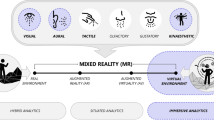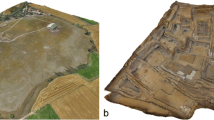Abstract
Collaborative Virtual Environments provide a place to meet for co-workers who are physically distributed from each other. The presentation of the environment may be a simple textual interface or it may be a sophisticated multimedia interface involving video conferencing, electronic white-boards and so on. In our work we are interested in virtual reality as the medium of communication. This means that co-workers meet in a 3- dimensional, virtual world and are visible to each other as figures, or avatars, in that world. The world itself may have scenery and devices that represent some model of a real-world office. Now representing a virtual office is an interesting first step but it does not exploit the full potential of virtual reality. The true power of virtual reality lies in combining the real and the abstract. Thus in our worlds we wish the users to inhabit a landscape that is created from some set of information that they share as a working group.
Access this chapter
Tax calculation will be finalised at checkout
Purchases are for personal use only
Preview
Unable to display preview. Download preview PDF.
Similar content being viewed by others
References
Carlsson C and Hagsand O, (1993), “DIVE - A Platform for Multi-User Virtual Environments”, Computers & Graphics, pp. 663–669, Vol. 17, No. 6
VRML (1997), The VRML 2.0 (VRML97) Draft International Standard, ISO/IEC DIS 14772.
Broil W, England D (1995), “Bringing Worlds Together: Adding Multi-User Support to VRML”, Proceedings of VRML 95 Symposium, ACM, New York, 1995.
Mariani, J. A., Benford, S. and Rodden, T. (1995) “Populated Information Terrains”, Fadiva 1 Workshop, Seeheim, Arbeitspapiere der GMD 909, GMD Sankt Augustin.
Ingram, R. and Benford S. (1995) “Improving the legibility of virtual Environments” in Proceedings of the 2nd Eurographics Conference on Virtual Environments, Monte-Carlo, Jan/Feb. 1995.
Lynch, K, (1960) “Image of the City”, MIT Press.
Bentley, R., Appelt, W., Busbach. U., Hinrichs, E., Kerr, D., Sikkel, S., Trevor, J. and Woetzel, G., (1997) Basic Support for Cooperative Work on the World Wide Web, in International Journal of Human-Computer Studies 46(6): Special issue on Innovative Applications of the World Wide Web, pp. 827–846.
England D (1995), Virtual Places of Real Work, workshop at E-CSCW ‘95, Stockholm., http://lister.cros.livjm.ac.uk/homepage/staff/crosdengl/Research/
England D, Prinz W, Simarian K, Stahl O, (1998)“A Virtual Environment for Collaborative Administration”, Proceedings of the International Conference on Virtual Environments on the Internet, WWW and Networks,(Earnshaw and Vince eds.), IEEE Computer Society Press, New York.
P Every, Slipping through the net: theories of realism in virtual space?, Visual Representation and Interpretation ‘98, Springer Verlag 1998
D K Manley, Theatricality and levels of believabilty in graphical virtual environments, Visual Representation and Interpretation ‘98, Springer Verlag 1998
Dave Snowdon, Chris Greenhalgh & Steve Benford (1995) “What You See is Not What I See: Subjectivity in Virtual Environments”. In Framework for Immersive Virtual Enviroments (FWE’95) 18–19th December, 1995, QMW University of London, UK
A Munro, Judging books by their covers: remarks on information representation in real world information space Visual Representation and Interpretation ‘98, Springer Verlag 1998
Author information
Authors and Affiliations
Editor information
Editors and Affiliations
Rights and permissions
Copyright information
© 1999 Springer-Verlag London
About this paper
Cite this paper
England, D. (1999). Visualisation of Data Landscapes for Collaborative Virtual Environments. In: Paton, R., Neilson, I. (eds) Visual Representations and Interpretations. Springer, London. https://doi.org/10.1007/978-1-4471-0563-3_19
Download citation
DOI: https://doi.org/10.1007/978-1-4471-0563-3_19
Publisher Name: Springer, London
Print ISBN: 978-1-85233-082-8
Online ISBN: 978-1-4471-0563-3
eBook Packages: Springer Book Archive





